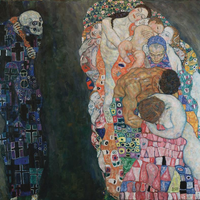More about The Coiffure

Sr. Contributor
Mary Cassatt was a master of creating soft and sensitive scenes of female private life.
Although she was an American artist trained in Paris, Cassatt owes the Japanese major props for inspiring her feminine take on the Impressionist style and subject matter. But Cassatt wasn’t the only artist absorbing the teachings of Japanese woodblock prints. Despite his awkward execution, Paul Gauguin basically lifted the weird, flat tree in Vision after the Sermon right from one of these prints. During this time, these prints were everywhere in Europe, and many Europeans were eager to pick up what the Japanese were putting down.
In April 1890, droves of artists and admirers attended an exhibition of ukiyo-e prints at the École des Beaux-Arts in Paris and learned that the Japanese were also interested in scenes of urban bourgeois pleasures, not unlike the Impressionists. The Coiffure is one of hundreds of images that Cassatt made after seeing this groundbreaking exhibition. She appreciated the fresh perspective and attention given to everyday scenes of female life, saving these images from being classified as mundane, and instead making them graceful. Having been trained by Salon superstar Jean-Léon Gérȏme, Cassatt easily could have made a career painting typical academic works in a tight, polished style. Instead, she started hanging out with Edgar Degas and got mixed up in the wild world of the Impressionists.
Unlike her male counterparts, who were out galavanting around Paris finding exciting scenes to paint, Cassatt dedicated much of her oeuvre to these private scenes of women’s daily lives. As a woman, her reality was grounded in the home, and she explored the female body as a compositional tool. The woman here basically has the body of Barbie doll because, although she is nude, we are not meant to think of her sexually. It is simply an intimate moment of a woman alone, styling her hair. Cassatt also enjoyed experimenting with printmaking techniques. Because they could be produced cheaply and en masse, printmaking was a more democratic artform than painting. Cassatt believed that all people had the right to enjoy and own original artworks, and she understood that printmaking made her art accessible to a larger audience than the paintings made for just the Salon-goers. However, not all artists shared this sentiment. John Singer Sargent, who made a name for himself by painting expensive society portraits, thought that producing prints devalued an artist’s work. This is a debate that continues amongst artists and gallerists to this day.
Despite Sargent’s bad attitude, Cassatt continued to create prints, and we’re sure glad she did. Her prints reside in museums around the world. This particular print found its way to the National Gallery of Art by way of Chester Dale, a banker turned art aficionado who began working at the New York Stock Exchange at just fifteen years old and eventually amassed a fortune that he used to buy great art. Although he lived in New York and some of his works are at the Met, the majority of his collection is at the National Gallery in Washington, D.C.
Sources
- Ives, Colta. “Japonisme.” In The Heilbrunn Timeline of Art History. October 2004. Departments of Drawings and Prints. The Metropolitan Museum of Ar., https://www.metmuseum.org/toah/hd/jpon/hd_jpon.htm. Accessed 3 November 2019.
- Khalid, Farisa. “Cassatt, The Coiffure.” Khan Academy. https://www.khanacademy.org/humanities/ap-art-history/later-europe-and-…. Accessed 3 November 2019.
- National Gallery of Art. “Chester Dale.” The Collection. https://web.archive.org/web/20090304155311/http://www.nga.gov/collectio…. Accessed 3 November 2019.
- National Gallery of Art. “The Coiffure.” Collection. https://www.nga.gov/collection/art-object-page.5933.html. Accessed 3 November 2019.
- Pound, Cath. “The Women Impressionists Forgotten by History.” Designed. BBC. 7 August 2018. http://www.bbc.com/culture/story/20180807-the-women-impressionists-forg…. Accessed 3 November 2019.
- Stanska, Zuzanna. “Paul Gauguin, The Vision after the Sermon.” DailyArt Magazine. 16 September 2018. https://www.dailyartmagazine.com/paul-gauguin-the-vision-after-the-serm…. Accessed 3 November 2019.
- The Metropolitan Museum of Art. “Mr. and Mrs. Chester Dale Dine Out.” Collection. https://www.metmuseum.org/art/collection/search/489260. Accessed 3 November 2019.
- Weinberg, H. Barbara. “Mary Stevenson Cassatt.” In The Heilbrunn Timeline of Art History. October 2005. The American Wing. The Metropolitan Museum of Art. https://www.metmuseum.org/toah/hd/cast/hd_cast.htm. Accessed 3 November 2019.












